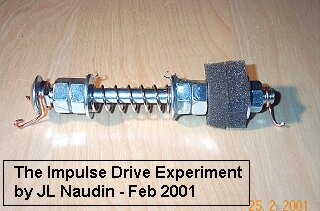
The Impulse Drive Experiment - IPD v1.0
Created on February 25th, 2001 - JLN Labs - Updated on February 9, 2002
All informations in this page are published free and are intended for private/educational purposes and not for commercial applications

The Impulse
Drive Experiment - IPD v1.0
Created on February
25th, 2001 - JLN Labs -
Updated on February 9, 2002
All
informations in this page are published free and are intended for
private/educational purposes and not for commercial applications
This experiment is the replication of the Henry Bull's Impulse engine demontrated in 1935. This experiment has also been conducted successfully by Alexander Frolov in Russia and presented during the International Conference in St Petersburg in 96, see "Collection of Lectures" by Alexander V.Frolov, published in Proceeding of International Conference New Ideas in Natural Sciences, 1996
<< The theory
is that a large weight with a low velocity ( if stopped by
springs ) will yield more foot pounds of energy than a small
weight with a high velocity being stopped by impact, even though
both were given the same initial force. A simple illustration:
Let us assume you are in the centre of a room in space. One wall
is elastic and the opposite one solid. In your hands are two
balls one heavy and the other light and you throw them with the
same force at the same time. The heavier one hits the elastic
wall with an impulse and a large amount of energy is given to the
room in that direction. The lighter one having the same energy
hits the solid wall but its energy is dissipated in heat and
distortion. If there could be found a method whereby the kinetic
energy of the lighter ball could be effectively utilised the room
would move in the other direction.
.....
It depends upon the difference in effectiveness of two ways
of transmitting energy, which can be termed impact and impulse.
If a weight is thrown against a solid wall, it is stopped by
impact, and much of its energy is wasted in distorting the weight
and the wall and in producing heat. However, if the weight is
thrown against a spring fastened to the wall, it is stopped by
impulse, the spring conserving the energy of the moving weight
and transmitting the resulting force, with little loss, to the
wall. Tests have shown a weight will yield three times more force
by impulse than by impact. >> has said Henry
Bull in an article published in Popular Science
in January 1935.
This is a very simple and cheap experiment that you can do by yourself, the material required is :
1 bolt, 10 mm diam and 140 mm length,
1 steel spring 45x15 mm
1 nut ( inner diam : 10 mm )
4 nuts ( inner diam : 12 mm )
2 wide washers ( inner diam : 10 mm )
a nylon wire
2 block of foam 30x30mm and 12mm thick
a lighter
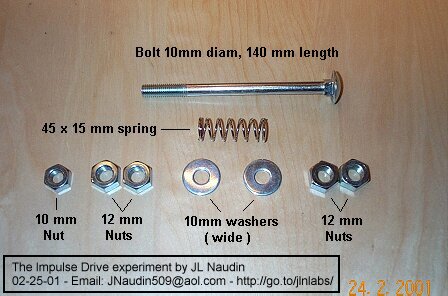
You need very few and cheap material for conducting yourself this experiment
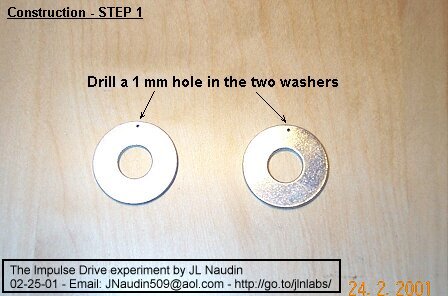
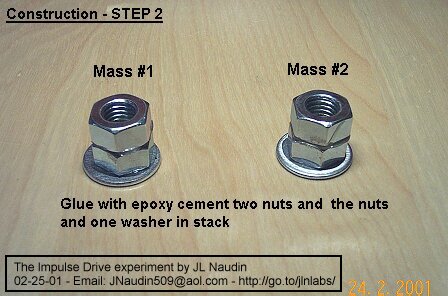

The Impulse Drive is
now ready for testing, compress the spring and attach a nylon
wire between the small hooks,
use a lighter for cutting the nylon wire and thus releasing the
sping. ( see the animation below )

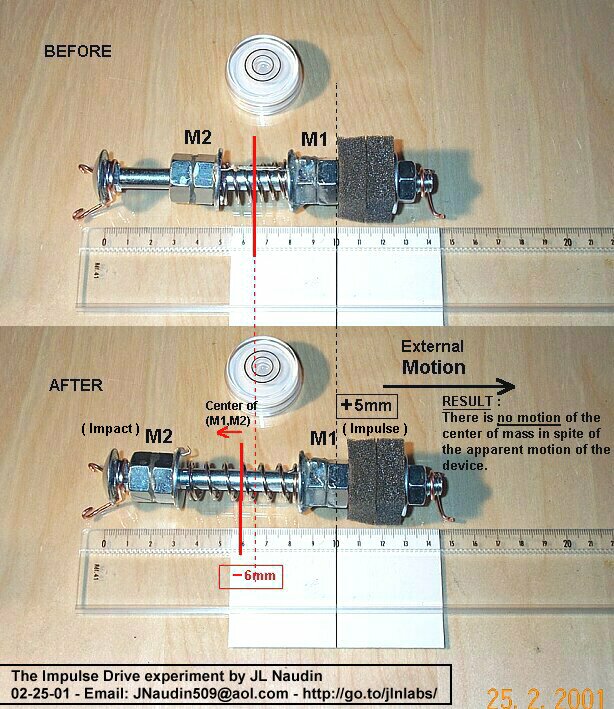
Impulse
drive specifications :
Test Results : When spring is released by the burning of the nylon wire, the Impulse Drive ( its support ) moves 5 mm from the left to the right but the internal moving mass M has shifted 6 mm from the right to the left, and we have : 84 g x 6 mm ~ 104 g x 5mm. Conclusion : Today, I am able to confirm the effect observed in the Bull's Impulse engine with this simple experiment: After that the spring is released the device has translated 5 mm in one direction. But, after a short analysis of the photos above you will notice that there is no motion of the center of mass in spite of the apparent motion of the device. This is only a 'one-shoot' experiment because the device needs to be resetted before each test, the net impulse in the Bull's device sums to zero over a complete cycle ( when the moving masses return to its initial position at the end the cycle ). Now in 2002...we can go further : In 1935 it was
not possible to build a reactionless drive based on the
Henry Bull's device by simply using a mechanical
apparatus. Today, its seems now conceivable to build a
spacedrive by using this kind of principle with a soliton wave or a transient mass fluctuation ( the Woodward experiment
which uses the Mach's principle
) instead of the old Bull's moving
masses. See the tests independant report : |
| Method
and apparatus for generating propulsive forces without
the ejection of propellant No. Publication (Sec.) :US6098924 Date de publication :2000-08-08 Inventeur :MAHOOD THOMAS (US); WOODWARD JAMES (US) Déposant :CALIFORNIA STATE UNIVERSITY FU (US) Abrégé : Mach's principle and local Lorentz-invariance together yield the prediction of transient rest mass fluctuations in accelerated objects. These restmass fluctuations, in both principle and practice, can be quite large and, in principle at least, negative. They suggest that exotic space time transport devices may be feasible, the least exotic being "impulse engines", devices that can produce accelerations without ejecting any material exhaust. Such "impulse engines" rely on inducing transient mass fluctuations in conventional electrical circuit components and combining them with a mechanically coupled pulsed thrust to produce propulsive forces without the ejection of any propellant. The invention comprises a method of producing propellant-less thrust by using force transducers (piezoelectric devices or their magnetic equivalents) attached to resonant mechanical structures. The force transducers are driven by two phase-locked voltage waveforms so that the transient mass fluctuation and mechanical excursion needed to produce a stationary thrust are both produced in the transducer itself. |
| Analysis of Woodward's Piezoelectric Capacitor Thruster by Steve Burns ( PDF document ) |

Animated photo
about the Frolov's Impulse drive experiment
( Photos courtesy of Alexander Frolov )
| << In this case we are
working with asymmetry of entropy: in one side of the
system we have produced heat that is realted to
microimpulses of particles (that is more entropy) and in
other side of the system we have produced elastic
interaction with minimum heat but with max kinetic macro
impulse transfer. So, after the spring become free and
masses were interated with the body of the system, total
impulse of the system should be constant and it is true.
But in one side of the system the part of the impulse is
transformed in microimpulses of elemental particles, i.e.
in heat energy. By that way we can produce macroimpulse
of the experimental system. >> Alexander
Frolov See the Frolov web site at : http://alexfrolov.narod.ru/frolov1.htm |
See the video of the JLN's Impulse Drive experiment
Download the Video of the test ( size 108 kb )
To see this video, the free
downloadable RealPlayer is required ![]()
Stick-Slip drives Vs Reactionless drives, be carefull... by J-L Naudin
See : The Stellar Drive Engine project from Robodyne Cybernetics
![]() Email : JNaudin509@aol.com
Email : JNaudin509@aol.com
Return to the Inertial Propulsion page